


Framed or unframed, desk size to sofa size, printed by us in Arizona and Alabama since 2007. Explore now.
Shorpy is funded by you. Patreon contributors get an ad-free experience.
Learn more.

- Details, Details
- What's that building to the left of the tower?
- Coal Barges
- Bromo-Seltzer
- Inner harbor
- The Basin
- What a headache!
- Giant stepladder?
- Baldwin 62303
- Baldwin VO-1000
- Cold
- No expense spared
- Tough Guys
- Lost in Toyland
- And without gloves
- If I were a blindfolded time traveler
- Smoke Consumer Also Cooks
- Oh that stove!
- Possibly still there?
- What?!?
- $100 Reward
- Freeze Frame
- Texas Flyer wanted
- Just a Year Too Soon
- WWII -- Replacing men with women at the railroad crossing.
- Yes, Icing
- You kids drive me nuts!
- NOT An Easy Job
- I wonder
- Just add window boxes
Print Emporium
Bliss: 1901
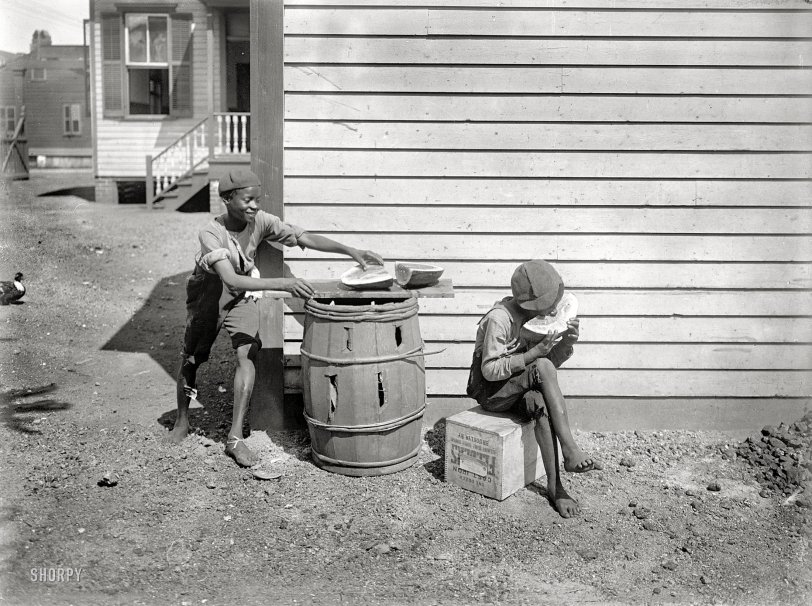
Circa 1901. The caption here is just like a watermelon, short and sweet: "Bliss." 8x10 inch dry plate glass negative, Detroit Publishing Company. View full size.
Watermelon days
Well this calls for a story. When I was a child in the District, we still had watermelon carts with horses. It would come down our street once maybe twice a week. My grandmother usually couldn't afford one, but every now and again she would surprise us. If we saw her at the watermelon truck we would wait patiently, until we saw the watermelon man hand her the goods. Then we would jump up and down, sing with glee and dance. There would be all kinds of carryins on. We would follow Grandma to the back of the house, our camp ground in the alley, "Grandma can I have a big piece" please? When we were done, we would play until dark. Then we would go to bed with sweet dreams of that beautiful fruit. Our hearts would swell because we knew Grandma loved us more that anything in the world. Just a simple watermelon story for y'all!
No bad intent
I doubt if there was any bad intent from posting this photo. It just is what it is. It is a part of the culture at the time. Being a historian, no one should try to squelch any part of history, bad or good. It all teaches us. On top of that, this a a nice photo! Two kids just enjoying summer's bounty! For anyone to read any more into it is racist in itself.
Relief
I haven't visited for a while and pictures like this and the seaside pics help take away some of the opressive heat that's all around. Boy, do love watermelon!
Slice of Life
I love these old photographs, thanks Dave for sharing them with us. I can see how a boy eating watermelon could push someone's buttons, but honestly, how much poorer would we all be if we could not see this photo, this brief window of this era and these two kids?
re: "One of the things I really love about Shorpy"
Then that's one of the things I really love about YOU, Dave. I guess it was naive of me to assume no one submits such comments here. Thank you for culling those out; that's mighty refreshing. One of the many, MANY reasons I make time to visit this site at LEAST once a day. You are appreciated.
Maybe it's 'cause I'm Canadian
but I completely missed the stereotype that is so upsetting to some. I had no idea that associating black people with watermelon could be offensive.
When I looked at the picture of boys and their snack, it was a picture of joy. When my eye first caught mudhooks' picture of "the new French cook" (before reading the captions) it was a picture of a woman playing a mandolin.
Like I say, maybe it's because I'm not American and our experience around slavery is different, or maybe it's because the world has changed and is closer to a time when people are just people, but I just don't get what the problem is.
As someone has said, if you're looking for trouble, look at how things are in the inner-cities today and do something about it.
Thank you
Thank you to Dave for a charming photo and to Mudhooks for your eloquent comment. Revisionist history is a dangerous thing.
One of the things I really love about Shorpy
is that although there are clearly 2 different schools of thought on this picture all the comments are clearly thought out, reasonable and respectful. Maybe a couple little pokes here and there, but no personal attacks or hatred. That's exceedingly rare for anything on this topic on the web.
[That's partly because we don't publish those comments. - Dave]
Sometimes a cigar is just a cigar
And sometimes, when you've typed the subject line, you discover there isn't much more to say.
Shorpy Unfiltered
I'm new to Shorpy but I'm now hooked, even going backwards in the archive from the first post to catch up!
I enjoy the unfiltered view of the past that we get on this site. We get to see photos taken through contemporary eyes of the day, like we're stepping through a time machine.
Of course, those eyes may have been accustomed to things being a way that they aren't necessarily anymore, or are now deemed unacceptable by many. If someone is overly sensitive to these things, which Gumbogirl or bmore may be, then a site full of old photos may not be for them.
You can count me in to the group that never thought of any racial stereotyping when I saw this photo. I can see how some might, but again... even IF the photo was composed with racism in mind (which we will never know), the era the photo was taken in must be considered. Myself, all I see is two kids enjoying watermelon on a hot day.
Finally, I fully agree with Dave that each picture is interpreted differently by each person... and that's what makes them special and causes them to invoke discussion. I get disgusted by things like racist WWII propaganda posters but hey, it is what it is.
Surprisingly thought provoking
Although Dave's intent to simply post a light-hearted summer scene was clear, at first I was slightly uncomfortable with the stereotypes portrayed in the staging of this photo. Fortunately, the way commenters brought up and discussed the racial context reminded me what a educational resource this site is, thanks to the engaged community Dave has attracted.
Years ago, seeing the simple minded racism of blackface and mammy figures etc. with descriptions of their historical context forever changed my views on race in America. As awful as the racist ideas and caricatures of our grandparents' time were, doesn't pretending they never existed make it harder for modern people to put current racial problems into proper perspective?
The Mark Twain quote was a perfect fit with both the scene as well as the problem of presenting America's racial history honestly and sensitively, given the recent debates over the dialects and characters in some of his books. Would we be better off today if we banned Huckleberry Finn because we cringe at its period language and imagery?
We know African Americans of this time were subject to incredibly stupid racist ideas and behaviors. That shouldn't make us erase people like these kids from our national memory. The children in this picture lived in an unjust time, but they deserve to be remembered today as much as any white kids on Shorpy. The alternative - banning another period picture because racism was so prevalent - doesn't serve history or modernity well.
I think Dave and the community here did well by these kids and the issues this photo raised.
White Washing History
I've been reading the comments on this issue, and I can see both sides. The image does have racist overtones. You can bet that the photographer knew exactly what he was shooting when he took this picture of two Black kids and the watermelon, and I have no doubt that he might have used terms a lot more offensive than Black, Negro or even "colored." And it's not something that went away easily. I have a National Geographic from the 1930s that shows a raggedly dressed African American youth sitting on a wagon load of watermelons having a slice and wearing a big grin on his face. Eddie Anderson whose character of Rochester was, at the time, considered a major step forward in portrayal of Blacks in the media was regularly portrayed as shooting dice, partying non-stop on Central Avenue (in Los Angeles), stealing chickens and wanting to grown nothing but watermelon.
But the fact is that photos like these are a documentation of their times and those times were a prejudiced period. And not just towards African-Americans. Native Americans, Mexicans, Asians (usually defined generically as Chinese) and whatever the current wave of immigrants might have been were also subjected to a prejudiced portrayal. Look at some of Hine's tenement photos and the descriptions he provides for them and you will not get a very negative view of new Italian immigrants.
My view is that you can't set aside pictures like these to see only the "comfortable" vision of history that shows only positive images. You need to approach it "warts and all" and part of that is seeing the warts. Most importantly you have to talk about it and put it into context. That's the only way that things advance.
I get such a laugh from all
I get such a laugh from all of this. Especially from all of you self righteous people who feel that this is a derogatory photo. First of all, do you know where stereotypes come from? ….well, they’re formed from observations. And as far as the political repression of minorities…do you really think that this photo has anything to do with that? I mean really…..where does that even come from? I think that you look at this photo and you are feeling something that doesn’t really exist. “You” are making this into some crazy statement….and no-one else.
Do you feel that we should get rid of any photo that may be offensive to someone? Or only the ones that “you” feel are negative? If you erase or deny the past, you will loose the link to how we got to where we are today. There were an awful lot of white people who risked everything that they had, including their lives, to make sure that blacks would get an even shake in this world, and now 150 years later there are still people standing up for you. Somewhere along the line this fact seems to be forgotten. Every chance that you get…you call foul. Just knock it off already, it’s a photo, not a political statement.
[It might be instructive to scroll down and read Gumbogirl's comment first, then this one, and weigh them separately on the Reasonableness Scale. I am not getting a reading up here. Tap tap tap. - Dave]
Tempest in a Teapot
I've been looking at this blog with great interest and affection for quite some time, but never felt the need to comment until now.
What I love about this blog is that it is a look at the American Century: it is a view of our past. To look at a 1901 image and declaim racism with 2011 eyes is not only ridiculous sophistry, but flummery as well. These images are part of the American experience and, in that context, these children certainly look very happy. Certainly happier than many inner-city children of today look.
As for slavery-guilt, I feel none. I am English, so my ancestors were enslaved by the Romans, denied the same rights in the political process as American blacks were here at home. However, I have somehow managed forgive Italians, and quite enjoy myself whenever visiting Rome.
Grow up, people.
[There's a bit of a difference between 2,000 years ago and one great-grandma ago. - Dave]
Aw Geez
Some people here need to get a life.
Just Sayin'.
Dave?
What makes you think my ancestors weren't bought and sold as slaves?
[Nothing does. - Dave]
What is so racist about watermelon?
I can't say I've ever seen a black person eating one.
Great discussion
There is a great dialog here and a good illustration of why it's so important to study history and understand context.
Thanks, Dave, for posting all the pictures you do, but mostly for also posting the comments--pro and con--about the content on this excellent site.
Regardless of the era
You never wear the cap with the bill straight ahead!
Chill out
I think there's a lot of misplaced guilt on parade here. Until I read all the remarks, the old stereotypes never even occurred to me. I just thought it looked like two kids having fun.
[Different people will have different perspectives. If your ancestors were brought to this country against their will as slaves, and their descendants objectified as "cute" (mammies and "pickaninnies" lumped in the same category as puppies and kittens, in a sort of racist kitsch that's become "collectible" on eBay), you might understandably have some opinions about pictures like this. - Dave]
Stereotypes
To not show photos such as this and have reasoned discussions about them would be "erasing the history."
When I worked at a certain children's museum and we were preparing for the opening, I was asked to put together a range of stereoscopic photos so that the children could view them. I carefully eliminated the obviously racist ones - like series of views "Mrs. Newlywed's new French Cook" where the wife catches her husband messing with the French cook and replaces her with
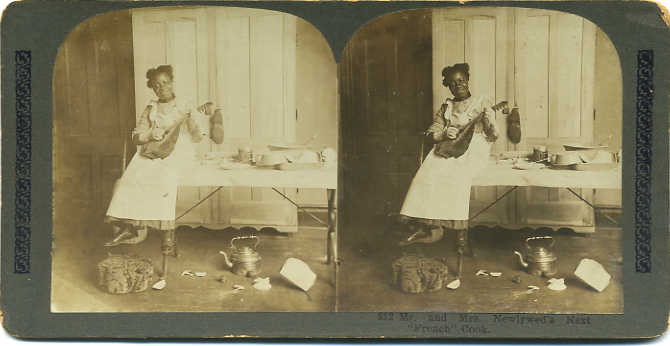
Amongst the ones I selected was a photo of a Japanese woman in her kimono looking at the devastation of the San Francisco earthquake. This was eliminated by the curator because of its "racist content". Firstly, I felt that it wasn't "racist" it showed someone who lived in San Francisco wearing, as many Japanese people in San Francisco of the day did, her normal clothes. Secondly, I felt that it revealed to children that there were people other than white people in San Francisco at that time.
As it happened, in order to "not present ethnic stereotypes" NONE of the images in the children's museum depicted any but white people...
The powers that be decided that in order to prevent any inadvertent "racist depictions", they would completely eliminate images of people of colour entirely.
If Dave starts eliminating historical photos which accurately depict attitudes, even what people in the day didn't overtly see as "racist" or "stereotypical" we'd have photos which exclusively present white males, buildings, and landscapes. The fact is that many of the images of women seen here, especially in the 1920s and 1930s depict stereotypical images of scantily-clad women which were taken basically to titillate men. I would no more, as a woman, expect that they be removed because they might be seen as raising an "uncomfortable" discussion.
As it happens, the great number of collectors of artifacts and ephemera with "stereotypical" depictions of African Americans from bygone days is African Americans. In collecting these items, they are making a concerted effort to ensure that the attitudes of the past, as offensive as they may be, are not whitewashed over.
--- Later...
I would like to add that I understand that there are varying viewpoints on whether the image posted by Dave is "offensive". The point I would like to make is that, as has been shown by some of the comments, many people are unaware that depictions of African Americans eating watermelon might have stereotypical connotations. Seeing such images and understanding that, however subtle, such imagery was the result of more overt and widespread racial attitudes.
I should also point out that the image I posted above was one of a number of "alternative endings" for the "Mrs. Newlywed's new French Cook". The last image was photographed with at least two other characters in place of the "lazy black cook" image - A fat "ethnic (possibly Italian) woman, for instance - to cater to the buyer's taste (or prejudice).
I am in no way suggesting that someone who finds the images offensive is wrong. My view is that people who come to Shorpy do so because we want to see the past through the eyes of our parents and grandparents, even when that view makes us uncomfortable.
Right on, Lectrogeek
I like the comment about Shorpy giving us "history unfiltered." Trying to ignore the subject matter of a particular photo, regardless of whether it offends our 21st century sensibilities, isn't going to change what happened back in the day. Let's hope, however, that we can all learn from that history and therefore ensure that it doesn't repeat itself.
As far as this being a part of our history we'd rather forget, how about the photos of dead Civil War soldiers in the trenches around Petersburg (also to be found here on Shorpy)? Is a photo of a dead Confederate soldier, lying in the mud with half his head blown off, any less disturbing? Even as an avid Civil War buff, I still have a hard time wrapping my head around the idea of Americans killing Americans, even if it did happen 150 years ago. But it's history, and we move on, and learn as we go.
Wah
I would give a lot to be as happy and content as these fellows look. I believe it to be genuine. This photo struck me as life in a less complicated time. Stereotype? Possibly, but so what. I guess crybabies gonna cry.
Aw nuts...
Here I was enjoying the memory of how my brother used to somehow manage to snatch up half of all my treats (watermelon, candy, cupcakes) when we were youn'uns. Then I started reading the comments and remembered there's supposed to be something inherently evil and racsist about 2 black kids eating watermelon on a hot summer day.
Welp... so much for nostalgia. Back to the real world.
Don't perpetuate the stereotypes!
Don't form your opinions from 110 year old photos. Instead, form your opinions based on the condition of most of America's inner-cities.
Hang in there, Gumbogirl
It's so subtle, I would bet that the photographer was oblivious to the stereotype, as most white people are today. I would argue that it is even more subtle now, since so much racist art has been systematically destroyed. It bothered me too, a little, and I'm white, for whatever that's worth.
Check here and here for some shots of an integrated 1890s US Navy, before Klan sympathizer Woodrow Wilson segregated all branches of the service. Those are just the shots that come to my mind at the moment.
Shorpy gives us history unfiltered. It's up to the community to provide the context.
Should have enlarged it first
I concede. It's a duck, not a chicken.
Stereotypes
I've also enjoyed this website for a long time, but presenting this picture as if it is just any other picture is not right. A picture of black people with watermelons is never an innocent picture. Along with numerous other racist images, from at least the mid-nineteenth century to the present day it's signified that African Americans are inherently lazy, child-like, improvident, and ultimately morally deficient in order to dehumanize them so that they can be denied political rights. That image isn't somehow balanced by showing pictures of raggedy white boys playing dice or white farm families enjoying watermelon because white people have never been denied political rights because of their race. Pictures of white boys eating watermelon aren't equivalent to pictures of black boys eating watermelon. It also doesn't matter if someone claims to see this image in a "positive" way because that history is always present and has meaning in society, whether or not any one individual chooses to recognize it. Presenting this kind of image without somehow dealing with its history just ends up perpetuating the stereotype and shoring up its purposes. This website isn't set up to be critical or analytical--it's a place where people can look at miscellaneous pictures of buildings and people and whatever from the past, make the pictures big and look for interesting details. To put that picture in this setting without discussion or comment is erasing its history, which is a bad idea considering how widespread this kind of stereotyping of African Americans and other groups still is in our society.
I Disagree With Gumbogirl
Yes the image is stereotypic but it is also interesting, and as historically significant as any other image on this site. We understand the context and the times of the image. Thanks and keep'em coming.
Acquired by art
Looks to me that the watermelon belongs to the boy that's seated, eating, and that the other boy is helping himself. Made me think of lines from Twain's autobiography:
I know how a prize watermelon looks when it is sunning its fat rotundity among pumpkin vines and "simblins"; I know how to tell when it is ripe without "plugging" it; I know how inviting it looks when it is cooling itself in a tub of water under the bed, waiting; I know how it looks when it lies on the table in the sheltered great floor space between house and kitchen, and the children gathered for the sacrifice and their mouths watering; I know the crackling sound it makes when the carving knife enters its end, and I can see the split fly along in front if the blade as the knife cleaves its way to the other end; I can see its halves fall apart and display the rich red meat and the black seeds, and the heart standing up, a luxury fit for the elect; I know how a boy looks behind a yard-long slice of that melon, and I know how he feels; for I have been there. I know the taste of the watermelon which has been honestly come by, and I know the taste of the watermelon which has been acquired by art. Both taste good, but the experienced know which tastes best.
Jeez
Thank God someone asked about the "cast iron feeders." At least some people aren't ticked off about black folks enjoying watermelon.
Heat index is 115 right now
I would be delighted if someone would offer me a nice slice of watermelon right now. And that would be equally true whatever my skin color happened to be. Some people are much too quick to seek offense where none is intended.
Lighten up
These are archival photos. I seriously doubt the photog at the time was wondering thru his viewfinder, "Geez, I bet this is will somehow be construed as a negative stereotypical image that I'm creating and in 100 years I will be lambasted for such by overly sensitive types in USA."
Like Sgt. Hulka once said, "Lighten up"
Thx
I will admit I cringed a little when I first saw this picture. Thanks for posting those white pics and putting things into perspective.
Raggedy clothes
I know people have commented on some of the raggedy clothes in this picture and others.
As the mother of an active boy about the same age, I just have to say healthy boys play rough. Even in this day where buying new clothes is easy and cheaper, my son will come home filthy and have ripped his clothes.
When I know he is going to play rough, I ask him to wear old stuff to spare the relatively useful outfits.
Come to think of it, I was pretty rough and tumbled as a little girl too!
Spittin' happy
You know, there's not much that cools you down quicker on a hot day than eating watermelon. I wonder what those kids would think of today's seedless watermelons?
I've been a faithful
I've been a faithful follower of Shorpy for over a year, but the repeated selection of these images with anti-Black stereotypes is making me reconsider that decision. I'm a trained archivist and researcher, and am fully aware of the history and meanings of such images. I'm also a Black American and each time I see one of these images on what used to be a favorite photo site, I feel slightly ill. Black people may have posed for these photographs and participated in the making of negative images, but there have always been people who opposed them (for example, organized protests in response to D. W. Griffiths' 'Birth of a Nation' and Oscar Micheaux' creation of a film in response).
Censorship isn't what I'm advocating here, but I do wonder: what is the purpose? When such images are presented without context or additional historical information, the stereotypes are revived and the cycle starts all over again.
It's hard not to feel a bit betrayed. I've commented before on some of the more dignified images presented here, such as Black Americans participating in the war effort, or pictured in the daily life of towns and industries. Even when the photos are painful to see (that image of French performer Polaire with her 'slave' servant, for example), we can learn from them. However, these were/are vicious, persistent stereotypes: dice playing, watermelon. Surely the editors of Shorpy have seen the widely circulated Internet meme with an image depicting an 'Obama White House' with watermelons on the lawn? This type of racism isn't dead.
I used to recommend Shorpy to all sorts of people. I may take a break and just go straight to the LoC Prints & Photographs Division for my personal browsing instead of making my daily visit here -- at least there's a bit more context.
I really would appreciate it if someone at Shorpy would address the question of why the dice and watermelon images were selected. Yes, they are part of our history, but they are not at all benign.
[I thought they were interesting. This one in particular because we're having a heat wave. Below: More craps-shooting and watermelon-eating on Shorpy. - Dave]
Watermelon
Yecch, hated it as a kid and I never did develop a taste for it. The seeds are a pain in the neck too.
Please People: It’s 1901.
Those fellows are not "stereotypes," they are REAL! (and enjoying reality too)
And the little duck too.
Stereotypical or not, these boys are enjoying themselves. One eating the melon; the other runnning up to see what the other (brother?) is doing? Perhaps it was staged. But there seems no exploitation. These kids are average looking kids of the American South, and are happy. It is refreshing to see. I also like the little duck waddling up, as if he too wants to get a slice of that juicy melon.
Why a duck?
Maybe the barrel was the duck's evening quarters. When I was a kid we had neighbors who kept a chicken in a bushel basket at night.
Same day (or week), different boys
I was hoping this was going to be of the same boys as the one from the other day, but these little boys are cute, too. They are certainly much more ragged than the other boys, but I am happy to be able to share in a happy moment in their lives.
P.S.
I believe the old adage,"Those who cannot remember the past are condemned to repeat it." Pictures like this are a reminder of how far we've come, and evidence that we can continue to make progress. Those four little boys were photographed doing things that, granted, could be construed as perpetuating stereotypes, but have been taken part in and enjoyed by Americans everywhere. I don't deny that the photographer may have brought the watermelon to the boys and set up the photo, but I agree with Caseyshebascott, that it doesn't look like they were being exploited.
Because of their race, we know that their lives were going to be hard. One of the main things I love about photographs is that it is an opportunity to remember people who lived before us. Looking at pictures of moments in their lives is, I think, a tribute to them. I think the boys in this and the other picture would be thrilled to know that there are people remembering and caring about them, 110 years later! The intent of the photographer for the pictures does not change the fact that those pictures are a gift to us, now.
One last thing; this is not the picture that I expected this kind of discussion from. This https://www.shorpy.com/node/10653 was. I cried over that one, to see that man, whose life we know, for sure, was very hard, treated like that, and for that reason! It reminded me of the horrible lynchings that used to take place, as recently as 50 years ago, and how thankful I am that my two black sons, and my biracial grandson, are not in danger of such a thing.
Stereotypical
We saw in another picture black kids playing dice for money, and now we see them eating watermelon. What is next? Dancing a jig? These pictures seem to show the stereotypes of the age in which they were taken.
I'm Stumped
I've been puzzling over what the one dozen cast iron items that were in the crate that one of the boys is sitting on, might have been. They began with the letter F.
[Feeders. - Dave]
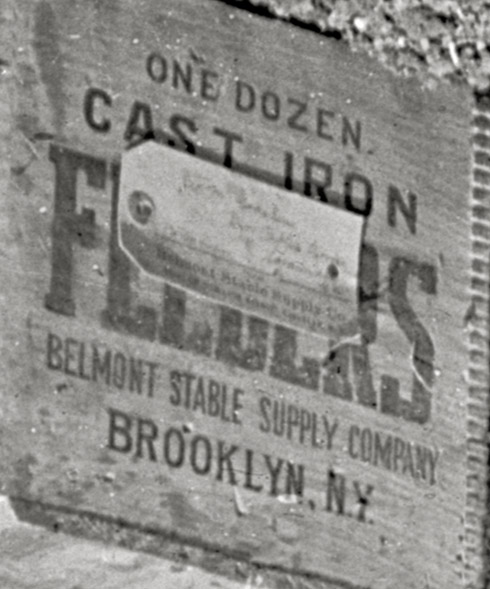
Just a guess
This photo "op" was set up by the photographer.
Summertime joy
What a beautiful, natural smile on the face of the standing boy, he looks like a young and beaming Michael Jackson. As for the lad engrossed in his snack sitting on the crate, he reminds me of the commercial saying "Don't bother me, I'm eating." When I saw the title "Bliss" I thought it was going to be the now-famous Bill Bliss of Shorpy fame, but he was not around in 1901. This photo takes us all back, I'm lovin' it.
























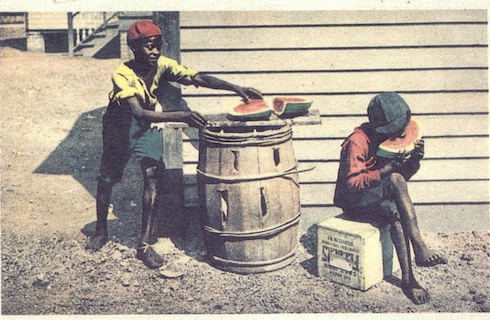
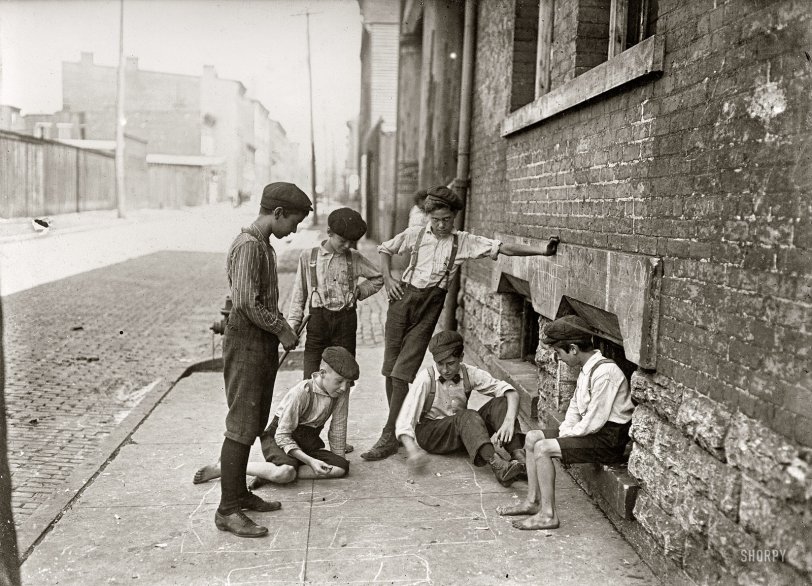
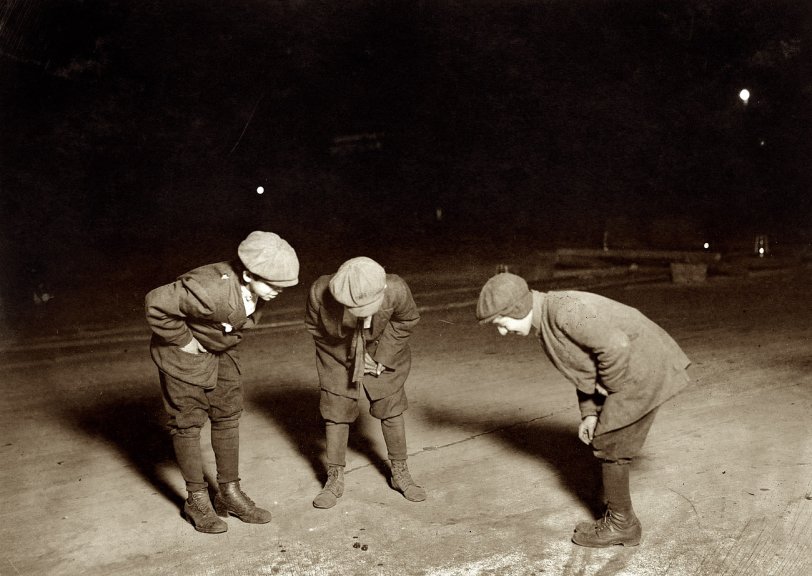
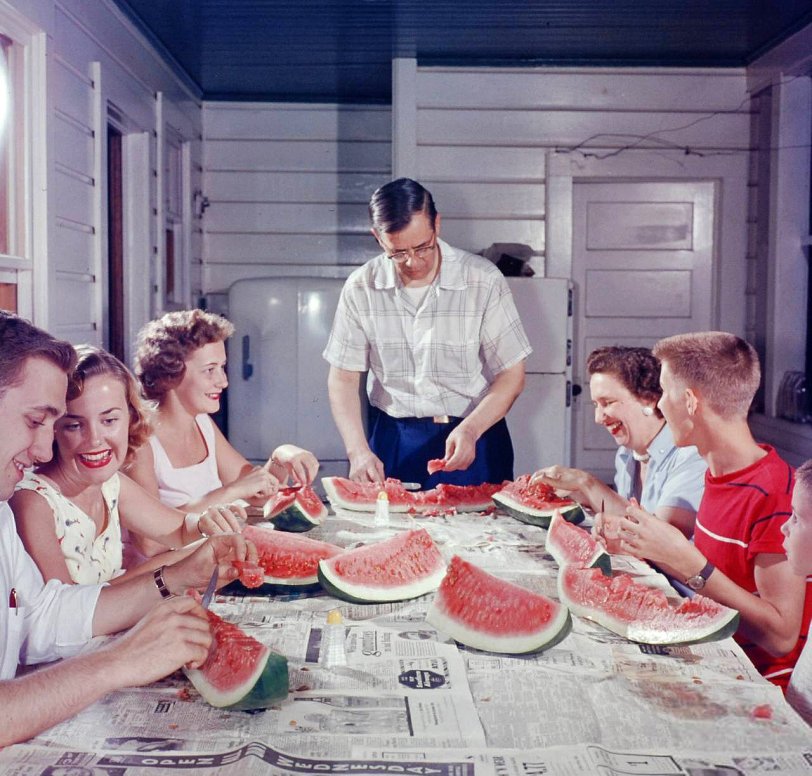
On Shorpy:
Today’s Top 5